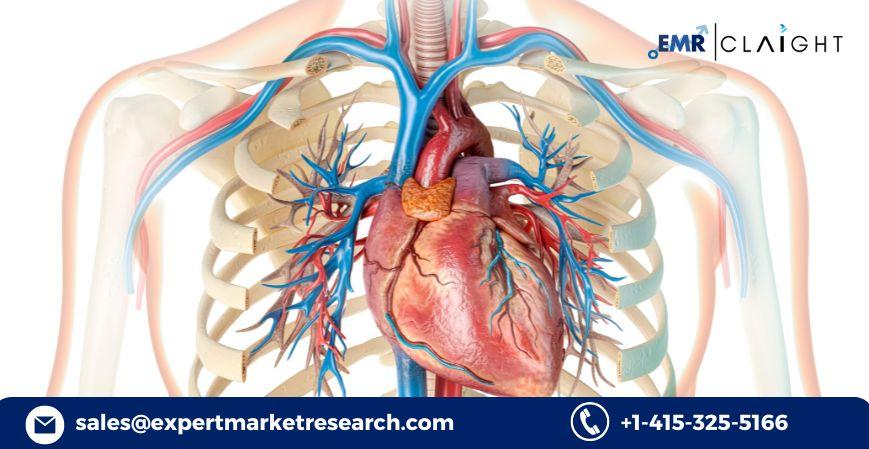The United States heart valve devices market is experiencing strong growth, chiefly driven by the increasing prevalence of valvular heart diseases, a growing aging population, and technological advancements in minimally invasive treatments. The U.S. market was valued at approximately USD 3.59 billion in 2024, and it is projected to expand at a compound annual growth rate (CAGR) of 9.60% from 2025 to 2034, reaching around USD 8.98 billion by 2034.
Factors contributing to this growth include rising rates of aortic stenosis and mitral regurgitation, expanded indications for transcatheter aortic valve replacement (TAVR) and transcatheter mitral valve replacement (TMVR), improvements in surgical and repair devices, and expanded access to ambulatory surgical centers (ASCs) and minimally invasive surgery (MIS) options.
Market Overview of United States Heart Valve Devices Market
Valvular heart diseases (VHD) affect millions of Americans and represent significant morbidity and mortality burdens. Degenerative valve disease, rheumatic disease residues, congenital valve anomalies, and infections all contribute to demand for device-based interventions. According to industry data, the global heart valve devices market is expanding rapidly, and North America leads regionally.
In the U.S., the combination of high health-care spending, advanced cardiac centers, regulatory support from the U.S. Food and Drug Administration (FDA), and strong reimbursement environment has enabled faster adoption of novel valve repair and replacement devices. The market covers both replacement devices (mechanical, bioprosthetic, TAVR, balloon valvuloplasty) and repair devices (surgical valve repair, transcatheter mitral/tricuspid repair).
Market Size and Share
As stated, the U.S. heart valve devices market was valued at roughly USD 3.59 billion in 2024 and is expected to reach USD 8.98 billion by 2034, based on the forecasted 9.6% CAGR. While other external sources estimate slightly different figures, the growth trajectory is consistent. For example, global prosthetic heart valve markets are estimated to grow at above 10% CAGR.
North America continues to command a dominant share of the structural heart devices market, with estimates showing the U.S. accounting for the lion’s share of market revenue in valve replacement and repair.
Request sample report: https://www.expertmarketresearch.com/reports/united-states-heart-valve-devices-market/requestsample
Market Breakup by Valve Type
-
Biological (Tissue) Valve: These comprise animal-derived or human donor tissue valves often used for replacement; increasingly preferred in older patients due to absence of lifetime anticoagulation.
-
Mechanical Valve: Made from synthetic materials (e.g., titanium, carbon), mechanical valves offer durability but require lifelong anticoagulation and carry bleeding risks.
In the U.S., tissue valves are gaining preference especially with expansion of transcatheter technologies and improved durability, while mechanical valves maintain niche use particularly in young patients where longevity is critical.
Market Breakup by Product Type
-
Replacement Devices
-
Mechanical Valve
-
Bioprosthetic Valve
-
Transcatheter Aortic Valve Replacement (TAVR)
-
-
Repair Devices
-
Surgical Valve Repair
-
Transcatheter Mitral Valve Replacement (TMVR)
-
Balloon Valvuloplasty Devices
-
The replacement segment remains substantial, but the fastest growth is observed in TAVR and TMVR products due to MIS adoption and expanding indications into intermediate- and low-risk patients. Repair devices are also gaining traction as less invasive options. Industry sources indicate that transcatheter technologies hold a strong growth engine globally.
Market Breakup by Procedure
-
Open Surgery: Traditional full sternotomy or minithoracotomy procedures remain the gold standard for many complex cases, but are declining in share.
-
Minimally Invasive Surgery (MIS): Includes TAVR, valve-in-valve procedures, and other transcatheter techniques, offering shorter recovery, less hospital time, and broader patient eligibility.
MIS is increasingly preferred from both patient and system perspectives, driving device innovation and market growth in the U.S.
Market Breakup by End User
-
Hospitals: Still the primary end-user segment as major valve procedures require operating rooms, cath labs, and cardiac centers.
-
Ambulatory Surgical Centers (ASCs): As MIS devices become safer and simpler, more procedures may shift to ASCs, boosting growth in that segment.
-
Others: Includes specialized cardiac centers, research institutions, and outpatient surgical services.
Hospitals currently dominate because of infrastructure and volume but ASCs represent a high-growth niche.
Market Dynamics and Trends
Key Drivers
-
Aging U.S. population: As patients age, degenerative valve disease increases the need for interventions.
-
Increased prevalence of cardiovascular diseases: Hypertension, diabetes, obesity, and metabolic syndromes contribute to valve disease incidence.
-
Technological advancement: Devices with improved durability, lower profiles, better hemodynamics, and expanded indication scopes.
-
Shift to minimally invasive and transcatheter approaches: Drives demand for specialized replacement and repair devices.
-
Regulatory and reimbursement support: The FDA’s streamlined pathways for structural heart devices and Medicare coverage for TAVR/repair enrich market adoption.
Trends
-
Expansion of TAVR into younger and lower-risk patients: Originally reserved for high-risk patients, TAVR is now used more broadly.
-
Growth of mitral and tricuspid repair devices: TMVR and tricuspid interventions are emerging fast.
-
Focus on durable and next-generation bioprostheses: Longer lifespan for bioprosthetic valves reduces re-intervention needs.
-
Integration of digital technologies: Imaging, AI, patient-specific planning and 3D-printing guide devices improve outcomes.
-
Rise of ambulatory procedures: Shorter stays and outpatient suitability are driving ASCs involvement.
Opportunities and Challenges
Opportunities
-
Unmet need in mitral and tricuspid valve disease: Many patients remain untreated; repair technologies offer growth potential.
-
Emerging patient demographics: Younger patients, expanded indications and earlier diagnosis widen the market.
-
Device upgrades and lifecycle replacement: Older valves and surgical stamp devices will require upgrading to newer models.
-
Emerging ASCs and outpatient settings: Shift in procedure venue opens new device markets and cost-efficient pathways.
Challenges
-
High device and procedural costs: Both hospitals and payers scrutinize value and cost-effectiveness.
-
Durability concerns and long-term data: Particularly in younger patients with bioprosthetics.
-
Regulatory and reimbursement hurdles: Novel devices must prove safety/efficacy and navigate payor landscape.
-
Competition and pricing pressure: Established major players face increasing competition and margin pressure.
-
Complex training and infrastructure requirements: Advanced MIS procedures require specialized teams and center accreditation.
Recent Developments
-
Abbott Laboratories gained FDA approval for its TriClip tricuspid valve repair device in the U.S., opening new tricuspid valve intervention indications.
-
Many major players such as Edwards Lifesciences Corporation and Medtronic plc are expanding portfolios, investing in new valve technologies, and partnering with research institutions to extend the life and performance of their devices.
-
The drive toward outpatient structural heart interventions continues with shorter hospital stays and more streamlined workflows.
-
Regulatory bodies in the United States increasingly recognize the value of minimally invasive structural heart devices and offer accelerated pathways and coverage policies to support adoption.
Key Players in the United States Heart Valve Devices Market
Major companies operating in the U.S. market include:
-
Medtronic plc
-
Edwards Lifesciences Corporation
-
Abbott Laboratories
-
Corcym Group
-
Boston Scientific Corporation
-
Artivion, Inc.
-
Micro Interventional Devices, Incorporated
-
Shockwave Medical Inc. (Johnson & Johnson Services Inc.)
-
JenaValve Technology, Inc.
These companies focus on technology leadership, broad product pipelines (replacement and repair), strategic partnerships, and geographic expansion in the U.S. heart valve sector.
FAQs
1. What is the United States Heart Valve Devices Market and what is its size?
The United States heart valve devices market refers to the U.S. market for medical devices used to repair or replace heart valves (aortic, mitral, tricuspid). It was valued at approximately USD 3.59 billion in 2024, with forecasted growth to around USD 8.98 billion by 2034 at a CAGR of about 9.6%.
2. What factors are driving the growth of the United States Heart Valve Devices Market?
Growth is driven by an aging population, greater incidence of valvular heart disease, technological improvements (especially transcatheter approaches), broader procedural indications, and increased adoption of minimally invasive surgery in the U.S. market.
3. Which types of heart valve devices dominate the U.S. market?
Replacement devices (both bioprosthetic and mechanical) dominate historically, but transcatheter replacements (TAVR) and repair devices (TMVR, tricuspid repair) are rapidly gaining share.
4. How are procedures changing in the U.S. heart valve devices market?
Procedures are shifting from open-heart surgery toward minimally invasive and transcatheter approaches, reducing hospital stay, improving recovery, and broadening patient access.
5. Who are the major companies operating in the U.S. heart valve devices space?
Key players include Medtronic, Edwards Lifesciences, Abbott, Corcym, Boston Scientific, Artivion, Micro Interventional Devices, Shockwave Medical (J&J), and JenaValve Technology.

